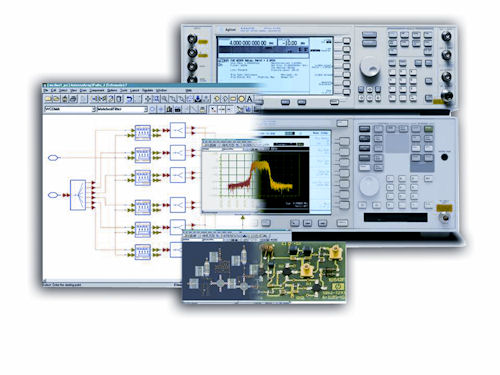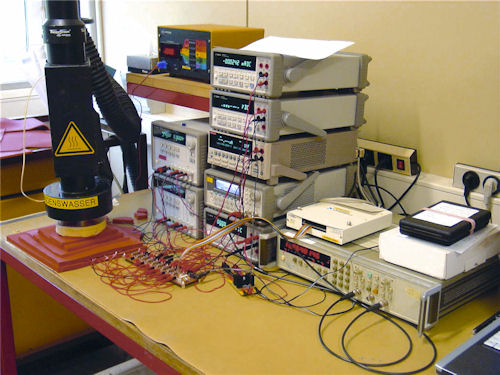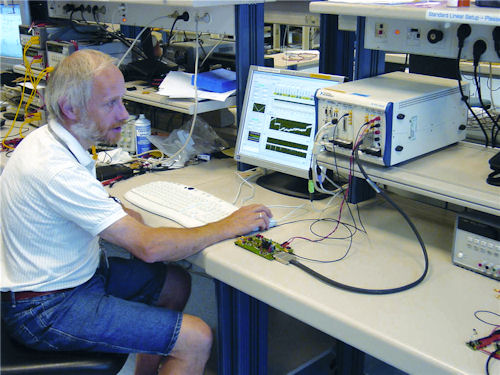Weigh Approaches to Test Instrumentation
Designers can customize how their test systems operate by modifying embedded software or by customizing the equipment itself.
November 1, 2012
By Debbie Sniderman
Test system architectures, independent of the instrumentations, consist of three main technologies: a piece of hardware that acquires a signal, a signal processor, and integrated circuits designed to be configured by a customer or a designer after manufacturing. The signal processor operates partly through embedded software existing within the test equipment hardware, and partly through field-programmable gate arrays (FPGAs). This approach is common across industries “all types of test equipment use the same building blocks.
 |
| Agilent’s strategy offers tight integration between the simulation-and-modeling environment and the test instrumentation, with common measurement algorithms. |
Test equipment is offered in different form factors “broken down into modules, benchtop, automated and embedded “to better fit a designer’s need. If a designer is debugging an electrical system and needs a quick scope measurement for rapid insight on the design, a benchtop form factor fits well. But if a designer needs to make a custom measurement with application-specific or proprietary protocols, customizable test equipment will fit better.
Degree of Customization is Important
Jean Manuel Dassonville, modular solutions outbound manager at Agilent Technologies, discusses some of the benefits and weaknesses of each approach.
“Embedded software is usually flexible, but isn’t fast enough to do signal processing in real time,” he explains. “Real-time processing needs an execution engine and a signal processing agent that is very fast. FPGAs can perform very high speed signal processing, but they have a limited number of agents. Processing signals with sophisticated algorithms may not fit within the constrained space of an FPGA, and you have to rely on software that has much more space to fit in.
 |
| The old bench setup for characterizing analog to digital converters, a form of integrated circuit testing. |
“Instrumentation has always involved a compromise between the speed of the measurement and the depth of the insight,” Dassonville continues. “You can use FPGAs for basic processing, and they’re fast, but it’s hard to accomplish accurate measurements or very complex processing.”
Dassonville maintains that of the three ways to make a measurement, the best quality will come from hardware that was designed to make the measurement. The only downside is that there is limited flexibility there. Using software to make the measurement gives you flexibility, but on the other hand, it can only process the signal that has been given by the hardware ““so if the signal isn’t good, the measurement quality isn’t either,” he says. As for the third option, FPGA? “It’s somewhere in-between,” Dassonville says.
Dassonville says it’s important to consider more than one dimension: Is the product modular? Is the software customizable? Both factors are important.
“It is possible to have a benchtop tester that is customizable, depending on the different degrees of flexibility that are enabled,” he says. “While one trend in the market is moving toward modularity, it’s not at the expense of benchtops. Not everyone needs customization. There are many applications that require quick measurements made ASAP. It’s not one against the other. Some are customizable, and others are less customizable.”
 |
| Using National Instrument’s new characterization test bench, based on the compact PXI, saves integrated circuit test development space and improves measurement quality and time, according to the company. |
Testing equipment vendors may not know the specifications of customers who deal with proprietary information, such as communication signals in military applications or signals that are defined with confidential specifications.
“Testing tools need to provide a degree of customization so engineers will be able to build test equipment to fit their needs,” Dassonville says. “Modularity brings flexibility, so you can customize equipment by putting modules together. But software customization is a complementary way to go even further, making sure that your test equipment fits the measurements you need to perform. Customers combine both by testing with hardware bricks that are modular, then customizing the software.”
The ability to customize measurements has existed for a long time. But Dassonville points out that there are more ways to customize today “with room to grow.
“We are seeing a proliferation of standards in the RF, computing and interconnect testing space, fragmenting the types of testing technologies used in the world,” he says. “There is a large market force driving our need to build testing equipment.”
Moving Toward Open Source
Luke Schreier, senior group manager for automated test at National Instruments, says we’re moving away from the 40- to 50-year-old testing instrumentation paradigm “a vendor’s view of how a problem should be solved “to a new, user-defined view. This new approach allows users to take reconfigured hardware and software packages and find the one that works best for them.
Schreier says some customers may not be ready for this new level of empowerment, and prefer the traditional vendor-defined view of the world. They know what they’re going to get: the warrantied, calibrated-signal instrument to which they’re accustomed. But while National provides this out-of-the-box traditional experience, Schreier says his company also allows users to “see every ounce of the software that runs on the instrument. All of the firmware is written in LabVIEW System Design Software and is open, so users can change it. Providing access to all of an instrument’s inner workings allows customers who aren’t doing something conventional to develop their own algorithms.”
An example of a customer who embraces this testing paradigm is someone who needs a relative calibration reference instead of a calibration to a standard that doesn’t mean much in real-time.
The industry is responding to both groups. Traditional-use cases can be solved in this new paradigm. And for those who think the idea is good, but the customization sounds complicated, Schreier says the LabVIEW community has a huge user base “and more than 26 years of data acquisition and complex automation design experience upon which to draw.
The industry is shifting its approach to software, making it as open for the user as possible, without needing vast domain knowledge in programming. Schreier says National takes the concept a step further, allowing users to program not only the software specific to their application on a PC connected to one of the instruments, but to write software that is on the instrument itself, reprogramming how the instrument works.
National is pushing the concept of allowing the user as much access to the software as possible, whether it resides on the host PC with which users are already comfortable, or on the instrument itself. By programming FGPAs inside, one piece of testing hardware could work in vector signal analyzer mode, in generator mode, or in a real-time streaming processing model.
This mode changes the nature of support, as well as the relationship between the customer and the vendor.
“After 36 years of supporting LabVIEW software, we have rigorous training and certification programs for customers to become well-versed in the tool,” says Schreier. “Customers can consult with not only a community of peers using the tools, but also consultants with expertise when custom development is desired. Once you modify the instrument, and take more ownership of the IP, you become the expert. You can always reload the original files that shipped with the instrument, and return to the original state. But, the more customization you make, the less advice we can give about how it should work. Since it’s written in LabVIEW, there are many people that can serve, support and add value to your customized code.”
National’s new Vector Signal Transceiver is the first combination of a calibrated instrumentation grade front end with a programmable FGPA. Schreier says there is a lot of interest from semiconductor and mobile chipset markets, among others, and customers have embraced how they are able to characterize 802.11 wireless LAN chipsets quicker and more efficiently using this open source approach.
Debbie Sniderman is an engineer, writer and consultant in manufacturing and R&D. Contact her at VIVLLC.com.
MORE INFO
National Instruments Video: “101 Things You Can Do With a Software-Designed Instrument”
National Instruments Video: “Introduction to the World’s First Vector Signal Transceiver”
Subscribe to our FREE magazine, FREE email newsletters or both!
About the Author
DE’s editors contribute news and new product announcements to Digital Engineering.
Press releases may be sent to them via [email protected].





